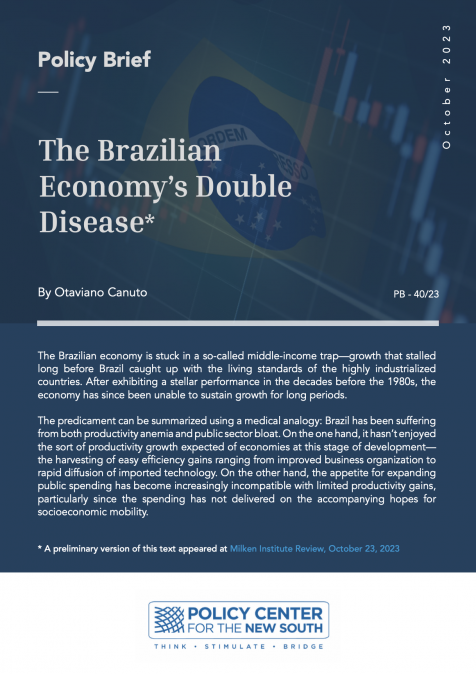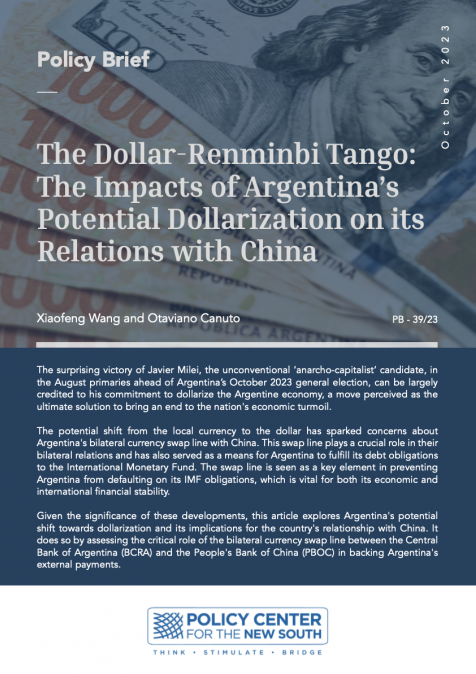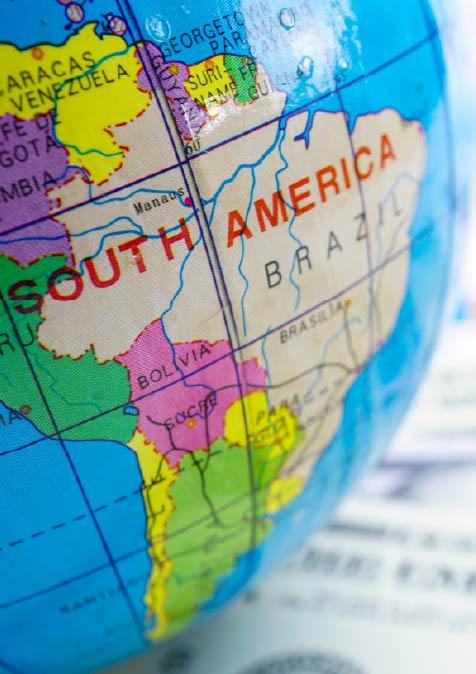Publications /
Policy Brief
The Brazilian economy is stuck in a so-called middle-income trap—growth that stalled long before Brazil caught up with the living standards of the highly industrialized countries. After exhibiting a stellar performance in the decades before the 1980s, the economy has since been unable to sustain growth for long periods.
The predicament can be summarized using a medical analogy: Brazil has been suffering from both productivity anemia and public sector bloat. On the one hand, it hasn’t enjoyed the sort of productivity growth expected of economies at this stage of development— the harvesting of easy efficiency gains ranging from improved business organization to rapid diffusion of imported technology. On the other hand, the appetite for expanding public spending has become increasingly incompatible with limited productivity gains, particularly since the spending has not delivered on the accompanying hopes for socioeconomic mobility.
* A preliminary version of this text appeared at Milken Institute Review, October 23, 2023
Introduction
One could almost hear the collective sigh of relief in Western democracies after Brazilian voters in 2022 rejected right-wing populism and the threat of a return to authoritarian rule. But a single election—a close election, by the way—will not cure the ills of Brazilian society. The country faces numerous chronic problems, ranging from a yawning divide between an urban middle class and a vast underclass, a deep distrust of governmental institutions, and a fragile environment, the destruction of which is exacerbating global climate change. A fresh start for the lagging economy is not, in itself, the answer to long-standing social and political problems. But it’s hard to see how Brazil will be able to move forward if it fails to deliver on its immense economic promise. Here, I analyze what has gone so wrong and what could be done about it.
The Trap
It is true that between 2003 and 2010, GDP rose at an average rate of 4.1% annually. Arguably more important, Brazil also put a serious dent in its shamefully high poverty rate. There was a catch, though: growth was underpinned by a massive (and unlikely to be repeated soon) boom in commodity export prices. After a deep recession in 2015-16, the economy grew by an anemic 1% annually from 2017 to 2019.
The slowest recovery on record was then retarded even more by the pandemic. GDP per capita today remains below the 2012 level and is less than one-quarter that of the United States in terms of purchasing power. And income distribution remains the most unequal in Latin America.
Macroeconomic mismanagement accounts partly for the stop-go performance since 1982. But Brazil’s economic woes can’t all be blamed on Brazilians; it has been hammered by global problems, including the foreign capital droughts after the Asian emerging-market crisis in the 1990s, and the financial crisis of 2008-09. However, its vulnerability is linked to structural issues that make it hard to take advantage of good news and hard to avoid the consequences of bad news.
To give a medical analogy, Brazil has been suffering from both productivity anemia and public sector bloat. On the one hand, it hasn’t enjoyed the sort of productivity growth expected of economies at this stage of development—the harvesting of easy efficiency gains, ranging from improved business organization to rapid diffusion of imported technology. On the other hand, the appetite for expanding public spending has become increasingly incompatible with limited productivity gains, particularly since the spending has not delivered on the accompanying hopes for socioeconomic mobility.
Productivity Anemia
Since the mid-1990s, Brazilian output per employee has been increasing at a snail’s pace of only 0.7% per year. That’s partly the consequence of relatively low investment in physical capital. But in large part it’s due to the dismaying pace of gains in efficiency.
Agribusiness is an exception. Productivity in Brazilian agriculture is rising well above the average rate globally. But its proportional impact on GDP is not enough to offset Brazil’s dismal performance in manufacturing and services. Which raises an obvious question: why is productivity growth so slow?
One reason is lack of competition. A combination of poor transportation infrastructure that limits geographic markets, differentiated state tax regimes, subsidies to specific firms, and fairly high barriers to import competition, make it more likely that inefficient firms will survive, with a price paid in terms of lower average productivity. Policies to support the private sector need to shift from compensation for high internal costs to strengthening the adoption and diffusion of technologies.
Then there’s the issue of education and the formation of human capital. In Brazil’s case, these could benefit from less-rigid allocation of public resources and the dissemination of successful experiences from states and municipalities, such as those in the northeast state of Ceará, where an alignment between rewards and students’ performance was established. Access to education by the population has improved in the past three decades. But quality has a way to go, as seen in Brazil’s scores in the OECD’s Program for International Student Assessment exams, which are far below Europe, North America, and East Asia.
Infrastructure
Brazil’s infrastructure stock has been depleting since 1990, when spending first fell below the level needed to maintain it (about 3% of GDP). The causes are as plain as they are painful: budgetary constraints that favor politically earmarked spending over investment, limited government capacity for project planning, and poor practices in procurement and contract and asset management.
While Brazil’s GDP doubled in real terms between 1990 and 2016 (and population growth, alas, nearly kept pace), the stock of infrastructure grew by just 27%. Infrastructure investment averaged over 5% of GDP between the 1920s and 1980s, a period in which per-capita income grew at an annual rate average of 4% and urbanization reached 60%. But in the past two decades, the pace of investment has fallen to less than 2.5% of GDP, even below its maintenance level. Although access to electricity and telecommunications has improved since the 1990s, basic sanitation and transportation networks fall short of those of Brazil’s peers, even taking into account Brazil’s huge land mass and low population density.
The fall in public investment has not been offset sufficiently by private investment in infrastructure, unlike in other countries in the region, notably Chile and Colombia. The need for ongoing fiscal austerity in the future (see below) reinforces the need to develop ways to tap private capital markets for public infrastructure finance. But it’s not just a matter of getting the money to accelerate the pace of public investment. Quality matters, too, and mismanagement is a serious barrier to success.
Take, for example, the deficiencies in resource allocation and operation. In transport, the bias toward roads over rail generates massive economic and environmental costs, equivalent to 1.4% of GDP, or 2.2 times the current annual investment in the sector. Meanwhile, operating inefficiencies in water supply have been around 0.7% of GDP, or more than three times the current annual investments in sanitation.
But when it comes to improved efficiency in the choice and management of infrastructure projects, the biggest barrier is political. The way in which political coalitions have traditionally been built and campaigns funded in the country’s recent past has led to the fragmentation of budget allocations for capital investment, and the frequent selection of poorly designed projects. This problem is hardly unique to Brazil. Japan, for example, is infamous for its bridges to nowhere. But Brazil simply doesn’t have the luxury of wasting scarce resources.
Barriers to Business
The World Bank’s annual Doing Business report compares the costs and delays a typical company faces throughout its life cycle in each country. In Brazil, recent changes—for example, in the kind of information that is made available to creditors and in the bankruptcy law—improved the country’s position in the rankings in the last report in 2020. But nonetheless, Brazil’s overall ranking—124 out of 190—puts it behind the likes of Tajikistan and Lesotho.
Brazil plainly needs further reform if it is to shake off its reputation as one of Latin America’s most frustrating business climates. Tax reform should be a priority: the system’s complexity makes fulfilling even basic obligations a challenge. In this respect, Brazil ranked a ghastly 184 out of 190 in the Doing Business report; don’t even ask which countries ranked lower. But here, there is also good news. The legislature approved a tax reform plan in July 2023 that will gradually simplify and eliminate redundancy in Brazil’s tax structure.
Another impediment to doing business is inefficient capital markets. Much was done to improve prospects in the second half of the 2010s, such as shrinking state intervention in credit allocation, and reducing the participation of large public banks in activities better left to the private sector. But there is still room to reduce costs and risks in financial operations between private agents.
Congressional approval of a ‘positive credit registry’, like a consumer credit-rating system, will have a positive effect on risk assessment and bank spreads. A new bankruptcy bill has been approved, which will complement the truncated reform that was approved in the first half of the past decade.
But more is needed. Widening the space for greater competition in credit options for consumers, including via fintech, would also help democratize access to finance. Facilitating such access on a sustainable basis would improve the business environment, and also strengthen the foundations for economic growth.
One other factor deserves a mention here: public corruption. Corruption can raise the cost of business in everything from obtaining zoning exceptions to protection against street crime. Even where it isn’t explicit, uncertainty about the honesty and the efficiency of courts in enforcing contracts, or administrators in assessing tax liability, effectively raises the cost of doing business. According to Transparency International’s Corruption Perception Index, Brazil’s score has fallen sharply in the last decade, to the point where its peers now include Tanzania, Moldova, and Belarus.
Trade Protection
Brazil has a long tradition of protecting domestic industry from foreign competition with the goal of industrialization—not to mention protection for powerful domestic interest groups. The economy is commercially closed. Consider, for example, tariffs on imports. Weighted by import shares, the average was 8.3% in 2015, the highest among comparable emerging and advanced economies. Arguably more important, tariff protection in Brazil is accompanied by nontariff barriers and local content rules, which also eclipse the efforts of peer countries to inhibit foreign competition.
Brazil manufactures an array of goods that one would never expect from an economy at this stage of development. Before assuming that this is inherently benign—or a shortcut to industrial advancement—note that by not making efficient use of externally sourced parts, equipment, and technologies, Brazil is a step behind in terms of productivity.
This is not to minimize the dislocation that would be associated with opening. Some producers would simply not be able to compete. Moreover, the gains linked to productivity would not be evenly distributed across regions and income strata, making it imperative to adopt complementary policies to facilitate labor mobility, retraining, and the generation of new jobs. None of this would be easy or politically straightforward. But business as usual is a recipe for stagnation.
The Potential from Open Trade
The causes of Brazil’s lack of competition and poor productivity performance go far beyond trade protectionism. Inadequate investment in infrastructure (as noted above), a difficult business environment, distortions in long-term financing, and inefficient use of public funds in education are high on the list. Brazil does respond to corporate demands to lower their costs, but mostly in ways that are immensely inefficient and don’t touch the root problems. By one estimate, the fiscal cost of policies designed to offset government-induced impediments to efficiency run to nearly 5% of GDP.
In addition to the agenda of overcoming those domestic barriers to greater competition and increased productivity, much could be done in trade policy, even in a global scenario in which unilateral gestures toward opening are unlikely to be reciprocated:
• The tariff structure could be simplified by reducing the number of tariff levels and by easing restrictions on imports of intermediate goods and capital goods, such as industrial machinery.
• An important nontariff barrier, local content requirements on finished goods, should be revisited.
• The tax burden on exports could be mitigated.
• Restrictions on imports of financial and professional services that serve as key inputs to production and export could be loosened.
It should be noted that, while Brazil is part of the Mercosur free trade bloc that includes Argentina, Uruguay and Paraguay, there is nothing in that arrangement that precludes additional initiatives within the group to reduce non-tariff barriers and, more generally, to reduce barriers vis-à-vis third countries.
The payoff could be very large. Simulations in one World Bank report suggest that with a combination of a better alignment of non-tariff barriers within Mercosur and a 50 percent drop in tariffs with countries outside the regional bloc, real income would rise enough to bring almost 6 million Brazilians above the poverty line of $5.50 per day. Again, though, it is important to remember that the total gains would not be evenly distributed across regions and income strata, making it imperative to adopt policies to offset the dislocation.
Public Sector Bloat
Notwithstanding lagging productivity and GDP growth, government spending rose by 68% in real terms between 2006 and 2017. Yet as a proportion of GDP, public investment declined to less than 0.7% of GDP. A report released in 2018 by the World Bank as “public policy notes” for Brazil lays out three reform paths Brazil could take to get back onto a trajectory of shared prosperity. Not surprisingly, in addition to the market-oriented proposals to improve productivity performance, the notes focused on better public-sector governance and offered an unsparing assessment of priorities in public spending.
With growth lagging badly in recent years, Brazil responded by allowing spending to far outpace tax collection. Indeed, public debt rose from 54% to 74% of GDP between 2012 and 2017, and peaked at 87% in 2020. The extraordinary fiscal support measures during the pandemic were made possible by suspending expenditure-ceiling restrictions embedded in the Constitution in 2017.
The expenditure ceiling is in the process of being replaced by a New Fiscal Framework submitted by President Lula to Congress, after his return to office in January 2023. The framework establishes tax revenue-dependent annual increases of public spending. But it is not expected to return the government to a fiscal trajectory that stabilizes the debt-to-GDP ratio. So public spending is likely to rise disproportionately, making it even more important to submit public expenditures to a full review.
The World Bank report highlighted opportunities for retrenchment in expenditures on social security, the public sector payroll, and business subsidies, which would minimize the impact on the poor and offer some room for increased spending for high-priority projects. In 2019, Congress approved a pension reform preventing outlays from carving out an ever-greater portion of public spending, but there remains the need to review other public expenditures.
Another path outlined by the World Bank is a broad rethinking of the role of the state. The mismatch between the limited growth potential that results from productivity anemia and the relentless pressure for public spending reflects a desire on the part of political leaders for the state to be all things to all people. The problem is aggravated by the government’s inefficiency in the provision of many services. Among the sources of inefficiency: fragmentation of service delivery, poor planning, monitoring and evaluation of projects, and human resource management without positive performance incentives.
This is the case for health, education, public safety, infrastructure, transportation, logistics and water resources management. In all of them, greater consistency between planning and execution, an emphasis on evaluation, and better coordination between public and private sectors would yield more bang for the real. The application of a gradual but steady treatment, while protecting the poor and the young, is the best cure for the public-sector bloat that has afflicted the Brazilian economy.
As well as helping to maintain a credible fiscal path that contains the ballooning debt, structural reforms aimed at boosting private investments could also make a big difference. The need for a multi-year horizon of infrastructure investment decisions makes the participation of the private sector vital for generating rational policy.
Concluding Remarks
Everything about Brazil is oversized—the population (at 217 million, the largest in Latin America), the land mass (fifth largest on earth), and by almost everyone’s reckoning, the economic potential. But so, alas, are its chronic problems that range from a lack of economic mobility to social divisions that undermine its capacity to make collective sacrifices in the quest for prosperity.
There are signs—there have long been signs—that Brazil could pull itself up by the bootstraps. Much of the world rides in passenger jets made in Brazil, works in office buildings erected with Brazilian steel, eats soy grown in Brazil, and learns from Brazil’s expertise in extracting oil in ultra-deep waters. Three of the eight largest hydropower installations on earth are located in Brazil, and more than half of Brazil’s energy consumption is derived from renewable sources.
But to turn promise into plenty, Brazil needs to make hard decisions that prioritize growth and poverty reduction over the demands of entrenched interest groups. It won’t be easy, but the gains would be worth the pain.








